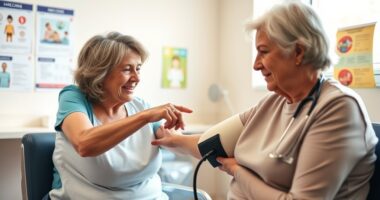Recognizing stroke symptoms quickly can save lives, especially in elderly adults. Watch for sudden weakness or numbness on one side of the body, speech difficulties, vision changes, severe headaches, dizziness, loss of balance, confusion, trouble swallowing, drooping facial muscles, or fainting. These signs often appear suddenly and require immediate medical attention. Being able to identify these warning signs early increases the chance of effective treatment—keep going to learn more about how to protect your loved ones.
Key Takeaways
- Sudden weakness, numbness, or paralysis on one side of the body indicates possible stroke.
- Rapid speech difficulties and trouble swallowing are critical signs requiring immediate medical attention.
- Abrupt vision loss, blurred vision, or flashing lights in one eye suggest stroke symptoms.
- Sudden confusion, memory issues, or behavioral changes can signal a stroke in elderly adults.
- Loss of consciousness, fainting, or sudden severe headache are urgent signs needing emergency care.
Sudden Weakness or Numbness on One Side of the Body

Sudden weakness or numbness on one side of the body is a common and critical sign of a stroke, especially in the elderly. Recognizing this symptom promptly can make all the difference in stroke prevention and effective emergency response. If you notice sudden weakness or numbness in your loved one, don’t wait—call emergency services immediately. Acting quickly allows medical professionals to assess the situation and start treatment as soon as possible. Early intervention can reduce long-term damage and improve recovery outcomes. Remember, rapid response is essential; every second counts. Educate yourself about stroke signs and maintain regular health check-ups to identify risk factors early. Risk factors such as age and health history can increase vulnerability. Being prepared and knowing how to respond can save lives and help manage stroke risks effectively. Additionally, awareness of innovative materials used in modern medical devices can improve outcomes through faster diagnosis and treatment. Moreover, understanding symptom recognition techniques can empower caregivers and patients to act swiftly when symptoms appear. Recognizing subtle signs early can also be supported by advancements in medical imaging technology, which facilitate quicker diagnosis and intervention.
Difficulty Speaking or Understanding Speech
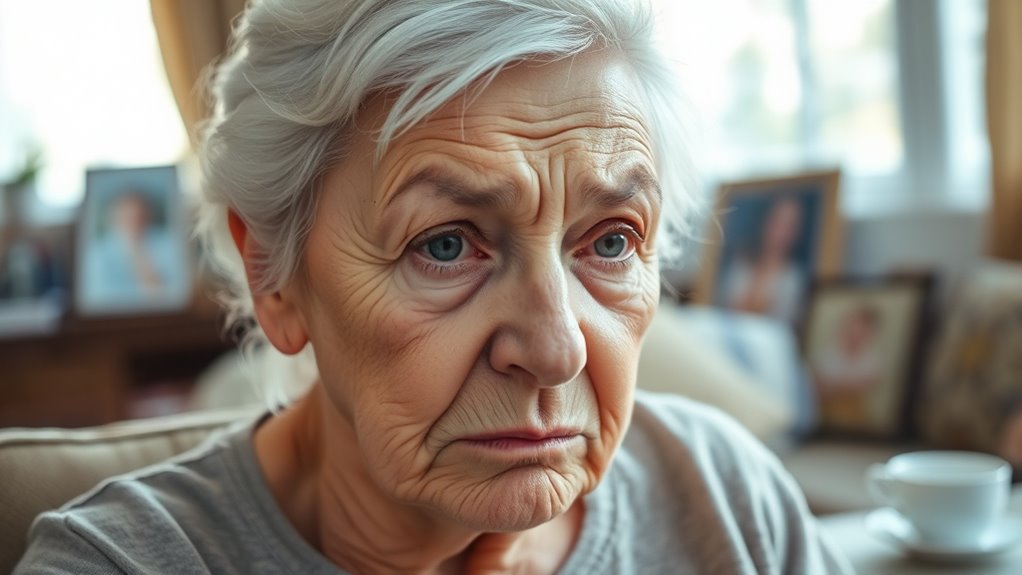
When someone struggles to speak clearly or cannot understand what others are saying, it often signals a stroke affecting the brain’s language centers. You might notice they’re having trouble forming words or finding the right ones, which can lead to frustration. This difficulty can create barriers to communication, making social interactions challenging and increasing feelings of social isolation. Recognizing these signs early is vital, as speech problems may come on suddenly and worsen quickly. If you observe that they are unable to speak coherently or follow simple instructions, seek emergency help immediately. Prompt treatment can reduce long-term effects and improve recovery chances. Don’t dismiss speech difficulties as just age-related; they could be a sign of a stroke needing urgent medical attention.
Sudden Vision Changes or Loss of Vision
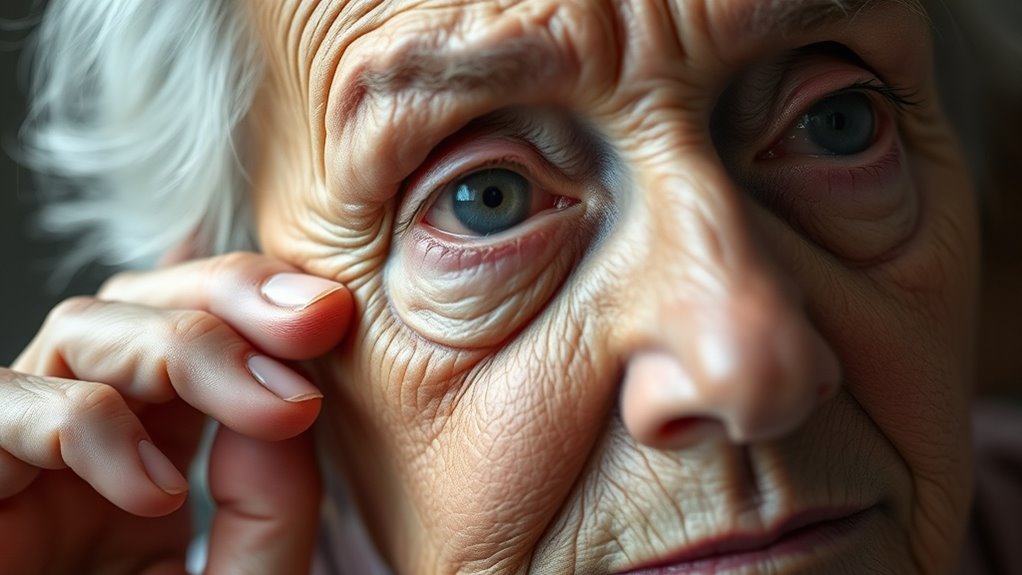
If you notice that an elderly person suddenly experiences blurred vision, partial loss of sight, or sees flashing lights, these could be warning signs of a stroke affecting the brain’s visual centers. Sudden vision impairment may occur quickly and without warning, often in one eye or as a shadow over part of their field of view. They might also complain of eye discomfort or a feeling of pressure. These changes happen suddenly and are not related to normal aging or eye conditions like cataracts. Recognizing this symptom is critical, as it indicates a possible disruption of blood flow to the brain areas responsible for vision. Blood flow disruption is a key factor in the development of stroke symptoms, emphasizing the importance of prompt medical attention. Prompt medical attention can prevent further damage and improve recovery chances. Always take sudden vision changes seriously, as they may be associated with other stroke symptoms requiring immediate care.
Sudden Severe Headache With No Known Cause
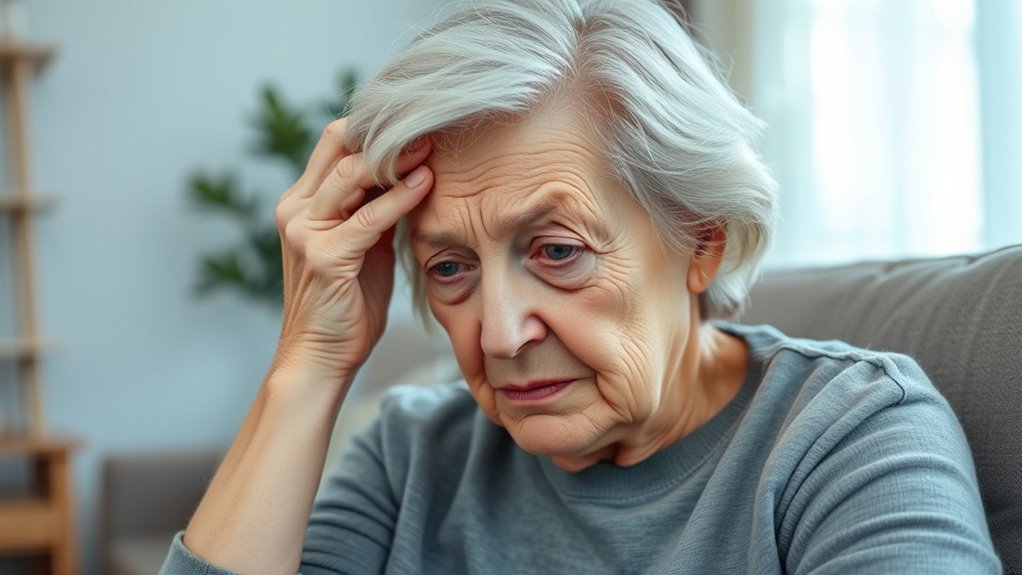
A sudden, severe headache with no clear cause can be a warning sign of a stroke. Pay attention to the timing and intensity of the pain, as well as any additional symptoms like weakness or dizziness. Recognizing these clues quickly can make all the difference in receiving prompt treatment. Knowing how to identify symptoms early can significantly improve outcomes. Additionally, understanding the signs of stroke and their limitations can support better decision-making in emergency situations.
Headache Characteristics and Timing
A sudden, severe headache with no known cause can be a critical sign of a stroke or other serious neurological issue. Pay attention to the headache’s characteristics and timing. Unlike typical migraines, which often follow specific patterns and last for hours or days, a stroke-related headache may appear abruptly and reach maximum intensity quickly. The headache location can vary, but a sudden, intense pain often occurs at the back of the head or on one side. If you notice a new, severe headache that doesn’t fit your usual migraine patterns, especially if it occurs suddenly and intensely, seek emergency medical help immediately. Prompt recognition of this symptom can be life-saving, as it often indicates an urgent neurological event. Recognizing abrupt symptom onset is crucial for timely intervention.
Accompanying Symptoms Significance
When a sudden, severe headache occurs without any clear cause, paying attention to accompanying symptoms can provide essential clues. These signs often include emotional responses like anxiety or confusion, and sleep disturbances such as insomnia or excessive sleepiness. Recognizing these symptoms helps differentiate stroke from other conditions. Additionally, understanding mental wellbeing can aid in early detection and intervention. Changes in brain function may also manifest as sudden weakness or numbness on one side of the body, which are critical indicators of a possible stroke. Being aware of neurological symptoms is vital for timely medical response. Recognizing subtle signs related to grocery store hours can also be crucial, as timely shopping can impact access to necessary health supplies during emergencies. Furthermore, paying attention to vascular health factors can improve early recognition and prevention strategies.
Dizziness, Loss of Balance, or Coordination Problems

Dizziness, loss of balance, and coordination problems can be warning signs of a stroke, especially in elderly individuals. You might experience sudden dizziness episodes or find it hard to stay steady when walking or standing. These balance issues can occur suddenly or gradually worsen, signaling a serious problem. If you notice yourself feeling unsteady or having trouble coordinating your movements, it’s vital to seek medical attention immediately. These symptoms happen because a stroke affects blood flow to parts of your brain that control balance and coordination. Recognizing stroke symptoms as a way to connect with healthcare professionals and experts can aid in early diagnosis and support. Additionally, understanding how managing stroke risk factors can prevent future incidents is crucial. Don’t ignore these signs, even if they seem minor. Acting quickly can make a difference in preventing further damage and improving your chances of recovery. Always consult a healthcare professional if you experience any of these symptoms.
Sudden Confusion or Difficulty Comprehending

Sudden confusion or difficulty understanding what’s happening around you can be a sign of a stroke. If you find yourself unable to follow conversations or get confused quickly, it’s important to act fast. Sometimes, language barriers or medication side effects can cause similar symptoms, but if confusion appears suddenly and without explanation, seek immediate medical attention. Elderly adults may experience cognitive changes from medication interactions or underlying health issues, but a stroke requires urgent care. Recognizing medical emergencies like stroke symptoms can be life-saving. Watch for sudden trouble grasping simple instructions or recognizing people. Don’t dismiss these signs as normal aging or side effects—prompt action can save lives. If confusion strikes suddenly and persists, call emergency services right away to ensure you get the help you need. Recognizing these symptoms early can be crucial, as cognitive changes are also a key symptom of stroke in elderly adults.
Trouble Swallowing or Drooling
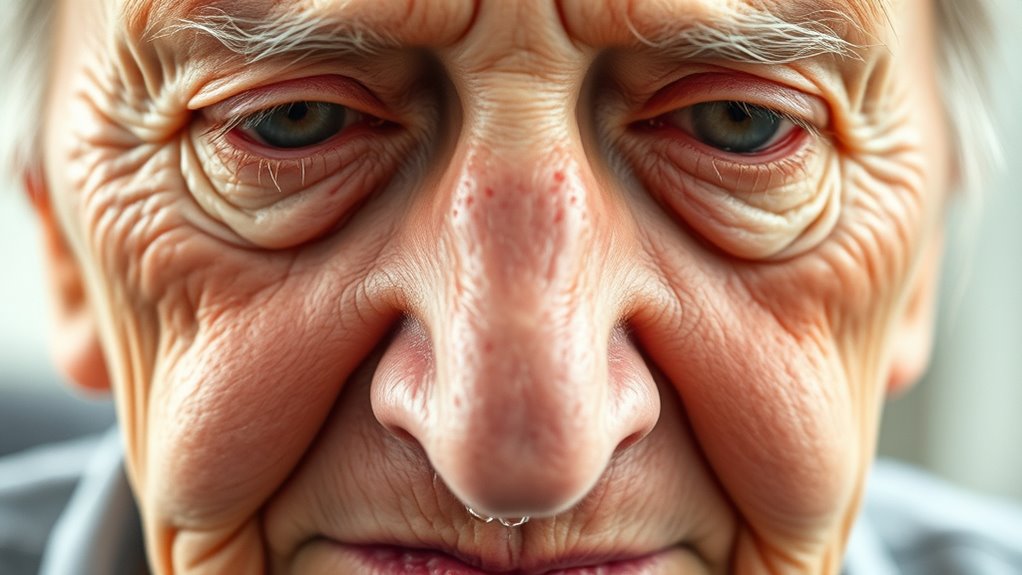
If your loved one suddenly has trouble swallowing or starts drooling excessively, it could be a warning sign of a stroke. These symptoms may indicate nerve or muscle weakness that needs immediate attention. Recognizing these signs early can make a vital difference in their treatment and recovery.
Difficulty Swallowing Signs
Difficulty swallowing or drooling can be early signs that a stroke is affecting the brain areas responsible for controlling oral muscles. You might notice swallowing difficulties, where food or liquids seem to get stuck or cause discomfort. This can increase aspiration risks, meaning food or liquids may accidentally enter your airway, leading to choking or pneumonia. If you or a loved one suddenly has trouble swallowing, it’s a warning sign that immediate medical attention is needed. Recognizing these symptoms early can prevent complications and ensure prompt treatment. Don’t ignore persistent or sudden swallowing problems—they could be an indication of a stroke impacting the muscles involved in oral control. Acting quickly can make a significant difference in outcomes and recovery.
Excessive Drooling Indicators
Excessive drooling can be an important sign that a stroke is affecting the brain areas responsible for controlling oral muscles. If you notice someone with increased saliva control or difficulty managing their saliva, it could indicate a stroke. Excessive drooling occurs when the muscles involved in saliva regulation weaken or become uncoordinated. This may happen suddenly or gradually, but it’s a warning sign you shouldn’t ignore. Watch for persistent or worsening drooling, especially if it’s paired with other symptoms like weakness or facial drooping. Recognizing these signs early can be life-saving. If you observe excessive drooling in an elderly adult, seek emergency medical help immediately to guarantee prompt treatment and better recovery chances.
Sudden Loss of Consciousness or Fainting
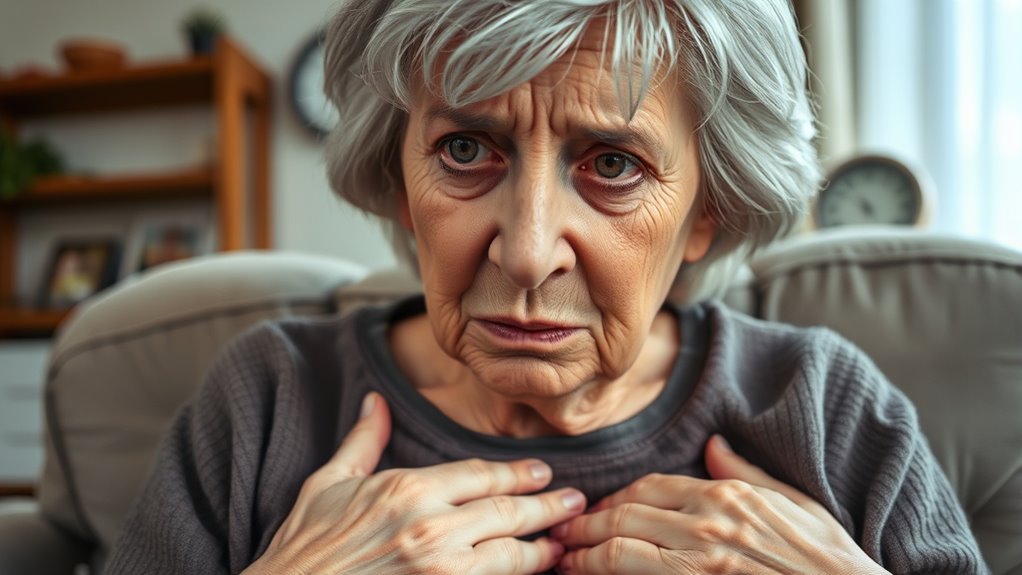
A sudden loss of consciousness or fainting can be a crucial sign of a stroke in elderly individuals. If you notice someone fainting unexpectedly, it’s essential to act quickly. Fainting may result from disrupted blood flow to the brain, indicating a possible stroke. Recognizing this symptom early can improve stroke prevention efforts and help you respond promptly. When someone loses consciousness suddenly, call emergency response services immediately. Stay with the person, keep them safe from injury, and monitor their breathing. Do not try to give them food or drink. Acting swiftly can make a difference in their recovery. Remember, quick action and knowing the signs of stroke are essential in saving lives and reducing long-term effects.
Unexplained Fatigue or Weakness
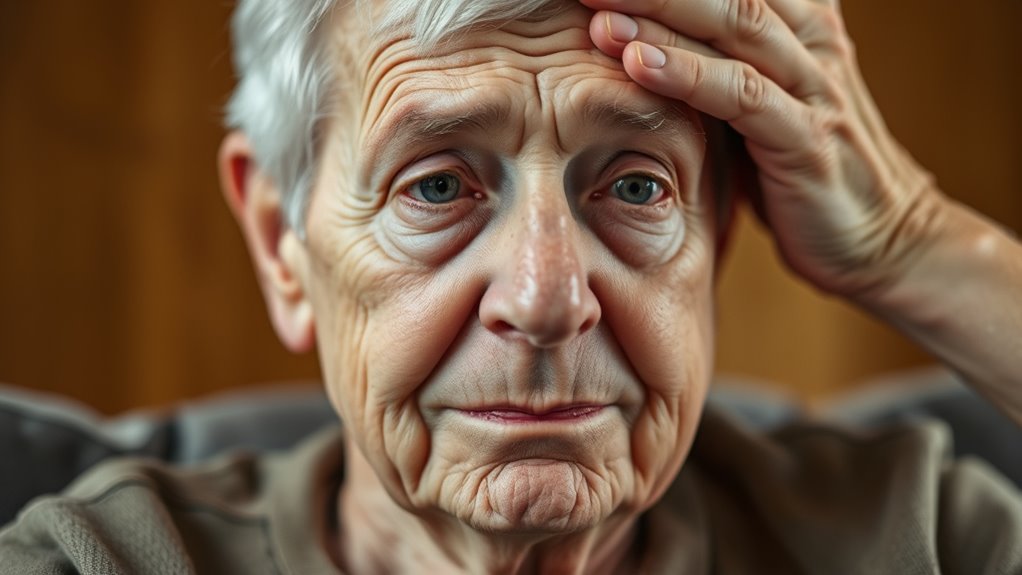
Unexplained fatigue or weakness can be a subtle but important sign of a stroke in elderly individuals. If you notice sudden, persistent tiredness that doesn’t improve with rest or a sudden drop in strength, it could indicate a problem. This type of exercise fatigue isn’t just everyday tiredness; it’s more intense and out of character. Nutritional deficiencies, like low iron or vitamin B12, can also cause weakness, but when combined with other symptoms, they may point to a stroke. Pay attention to sudden weakness on one side of your body or a general feeling of exhaustion that can’t be explained by activity levels. Recognizing these early signs can help you seek medical attention promptly, potentially preventing more serious complications.
Frequently Asked Questions
Can Stroke Symptoms Appear Suddenly Without Warning Signs?
Yes, stroke symptoms can appear suddenly without warning signs. You might experience sudden symptoms like weakness, numbness, or confusion without any prior indication. Recognizing that warning signs can sometimes be absent emphasizes the importance of acting quickly. If you or someone else shows any signs of a stroke, even if they come on suddenly and without warning, seek emergency medical help immediately to minimize long-term damage.
Are There Symptoms That Mimic Other Common Elderly Health Issues?
It’s no coincidence that symptoms like weakness, confusion, or dizziness often overlap with common elderly health issues, making differential diagnosis tricky. You might notice signs that mimic conditions like infections, dehydration, or medication side effects. Recognizing this symptom overlap is vital, as it can delay stroke diagnosis. Always consider the possibility of a stroke when symptoms appear suddenly, and seek immediate medical attention to guarantee accurate diagnosis and prompt treatment.
How Quickly Should Emergency Help Be Sought After Symptoms Appear?
When symptoms appear, you should seek emergency help immediately, as timely intervention can critically improve outcomes. Delaying an emergency response might worsen the situation or cause irreversible damage. Don’t wait or assume it will pass; call emergency services right away. Quick action ensures you get the necessary medical attention promptly, which is vital for effective treatment and reducing the risk of long-term disability.
Can Strokes Occur More Than Once in the Same Elderly Individual?
Yes, strokes can happen more than once in the same elderly individual. Recurrent strokes, or stroke recurrence, are common, especially if risk factors like high blood pressure or diabetes aren’t managed. You should work closely with healthcare providers to reduce your risk and monitor for symptoms. Prompt treatment after each stroke is essential to prevent further damage and improve your chances of recovery.
Are There Preventive Measures to Reduce Stroke Risk in Seniors?
Think of your health like a garden—you need to tend to it regularly. To reduce your stroke risk, you can make lifestyle modifications like quitting smoking and exercising more. Dietary adjustments, such as eating heart-healthy foods rich in omega-3s and low in saturated fats, also help. These steps strengthen your defenses, much like watering and weeding keep your garden thriving, making strokes less likely to strike.
Conclusion
Remember, recognizing these stroke signs is like catching a flicker in a dark room—quick action can save a life. When symptoms strike, don’t wait for the storm to pass; act fast, like catching a falling star. Your swift response can be the lighthouse guiding someone back to safety. Stay vigilant, because knowing these signs is your shield against the silent threat of stroke, turning uncertainty into hope and rescue.




